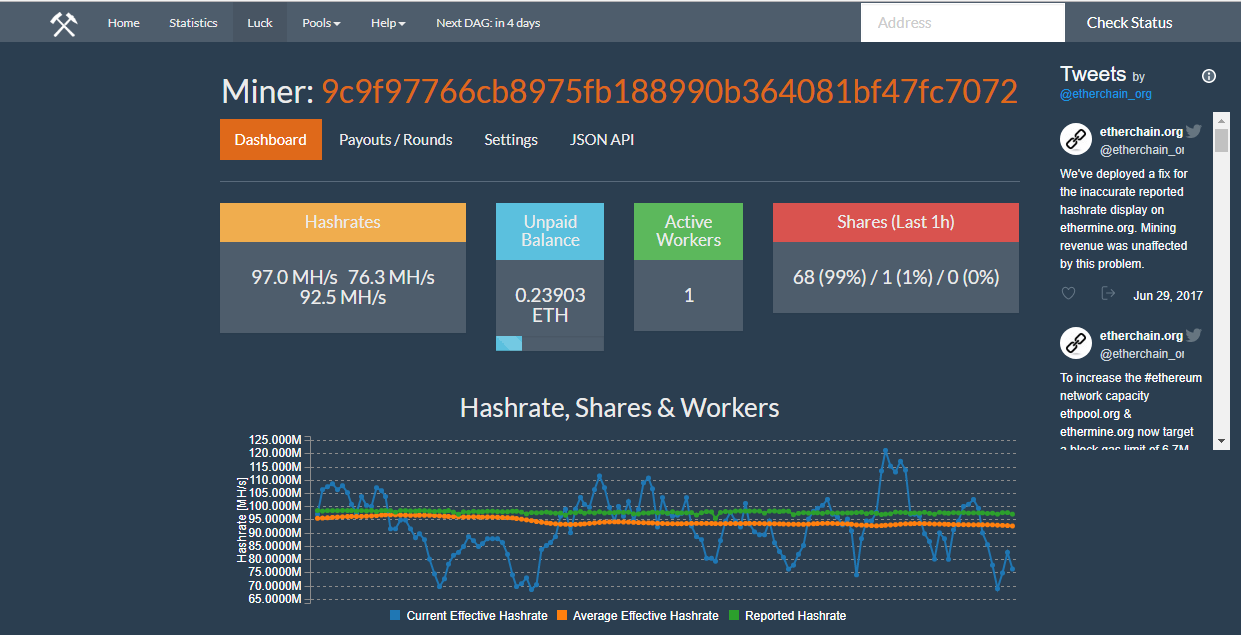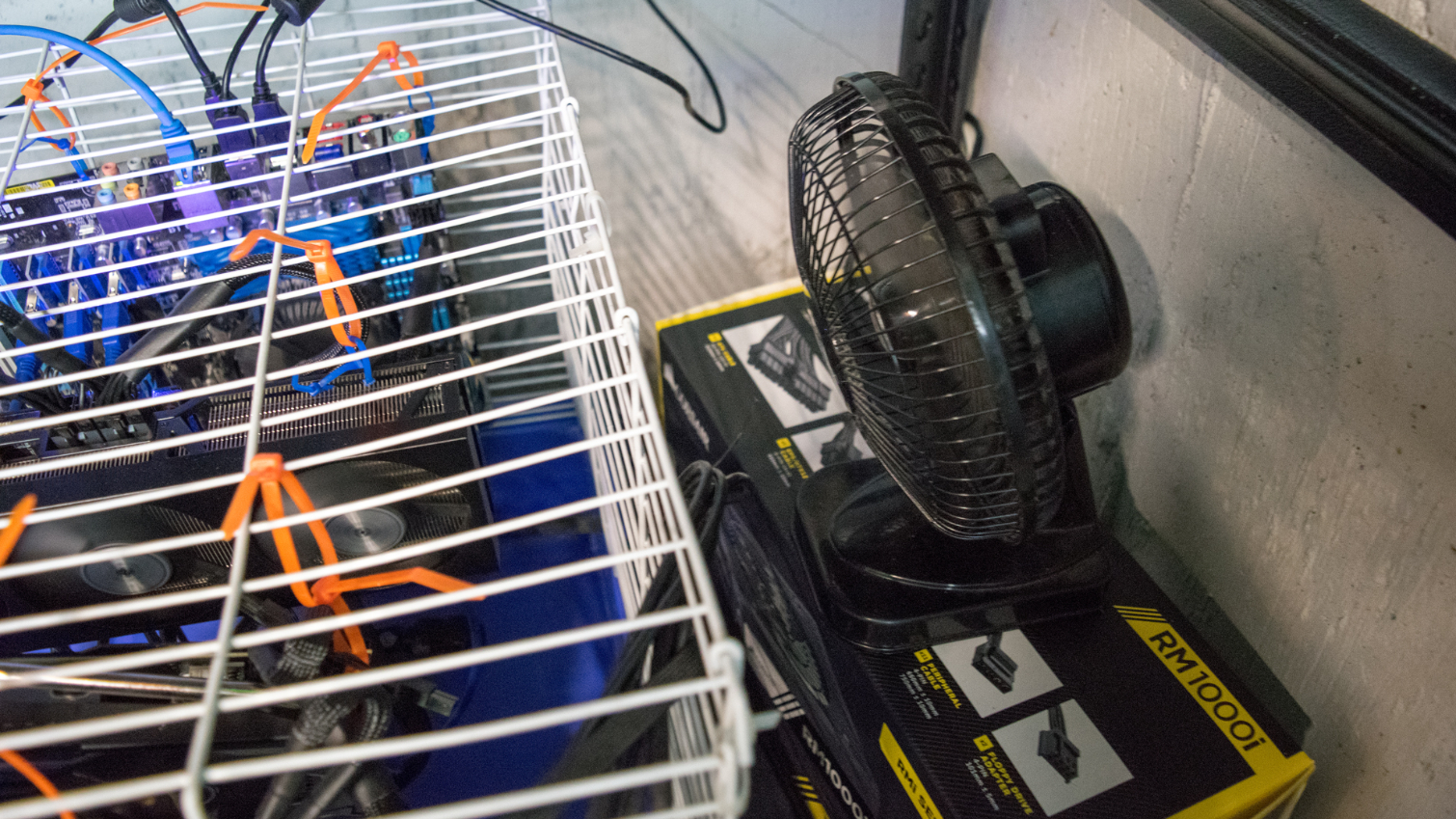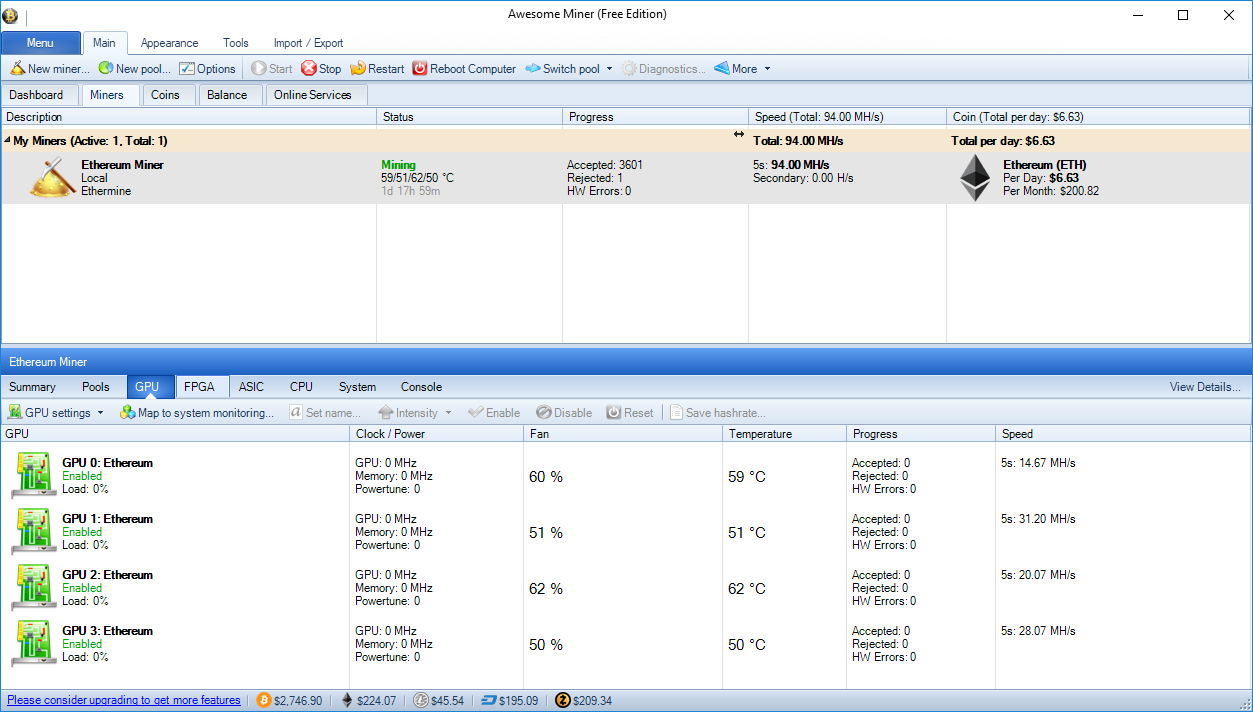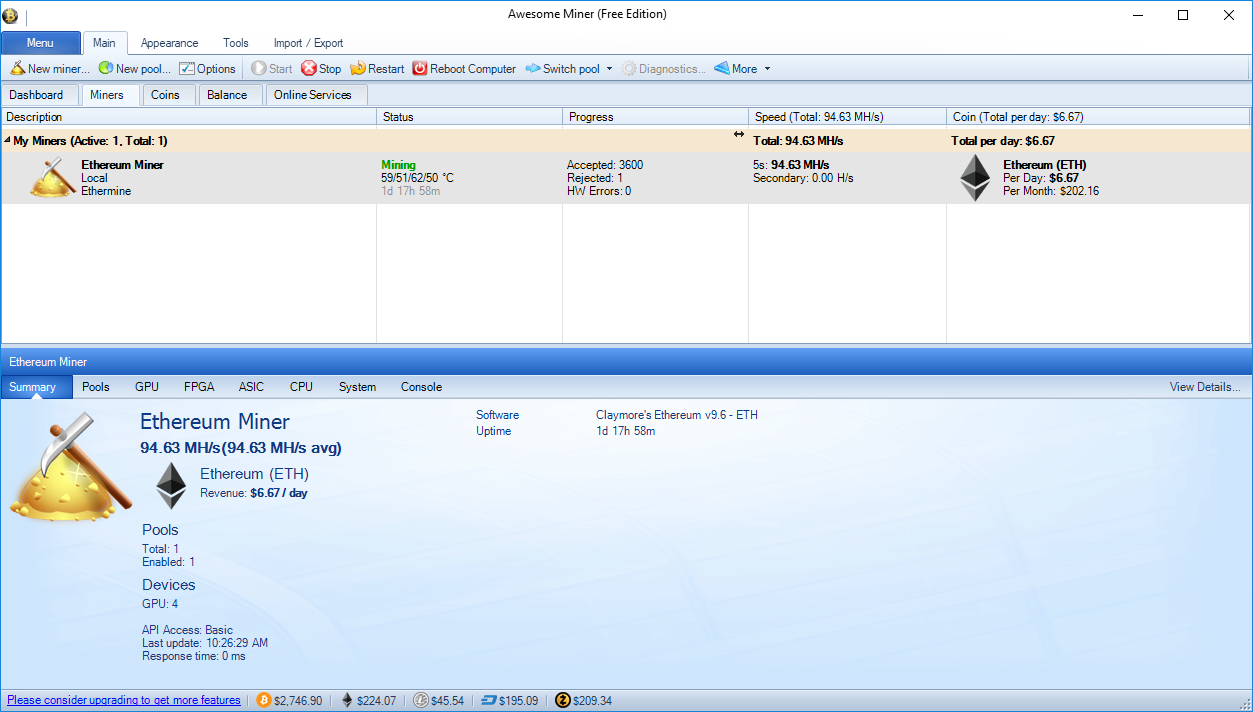Experiment: Build a (Profitable) Ethereum Mining Rig From Spare Parts
A Profitable Ethereum-Mining Rig Depends On Your Electricity Costs
How Much Mining Power?
I replaced the R9 390 with the water-cooled R9 390x, then added the R9 380 and fired up the system to see how powerful my multi-rig miner really was. With all four cards connected, Awesome Miner reports that the system is pushing out between 97 and 98 MH/s.
That amount of mining power demands a lot of electricity, and it’s pretty near maxing out the capacity of my power supply. The Watts Up Pro power meter reports that the system draws 935W from the wall. The Corsair Link software reports that the power supply sends 880W to the components in the system.
Managing Temperatures
I started this project with consideration for the heat that the rig would generate. Earning a little bit of extra money doesn’t make sense if I have to live in misery in a hot sauna. I placed the miner in my basement, which is typically cool.
After multiple days of operation, the R9 Fury is operating at 54°C, the R9 380X is sitting at 67°C, and the R9 380 hovers around 65°C. The R9 390X reports that it’s running at 56°C, but the air coming out of the radiator feels much warmer than that. I have a small fan blowing air through the cage to help dissipate the heat faster. The cards would be much warmer without the fan. When the air conditioning system is on in my house, the operating temperature of each card drops by anywhere from four to eight degrees.
After running this miner 24-hours a day for nearly a week, the basement is no longer uncomfortably cold. In fact, when I go down the wooden staircase, the first thing I notice is the extra heat on the back of my ankles. I wouldn’t characterize the basement as hot, but you can tell the rig is increasing the temperature in the room, especially when you stand in front of it. If the system were in my office where I work all day, I would have turned it off after a day. The extra heat that the system produces is only manageable in my large, cool, basement.
Don't Expect Peace And Quiet
It's possible to manage the heat with air conditioning and additional fans, but for every fan you add to the equation, the noise levels rise ever so slightly. With four cards and the extra fan running, the mining rig produces 54-56dB of constant noise. Admittedly, the small 8-inch fan that I'm running produces the bulk of the noise, but even with the fan turned off, the volume level in the room is considerable.
I have my rig in the same room that houses my home's central air system, so the noise is somewhat drowned out. But when the air conditioning system is off, you can hear the miner from 30 feet away. It's not unbearably loud where I have it, but in a smaller room it could be a nuisance.
Get Tom's Hardware's best news and in-depth reviews, straight to your inbox.
| Condition | dB level |
|---|---|
| PC Off, AC Off, Fan Off | sub-40dB |
| PC Idle, AC Off, Fan Off | 41dB |
| Miner Running, AC Off, Fan Off | 50dB |
| Miner Running, AC Off, Fan On | 54dB |
| PC Off, AC On, Fan Off | 41dB |
| PC Idle, AC ON, Fan Off | 43dB |
| Miner Running, AC On, Fan Off | 50dB |
| Miner Running, AC On, Fan On | 56.5dB |
| PC Off, AC Off, Fan On | 53.5dB |
And What Of The Profits?
Admittedly, we jumped onto the Ethereum bandwagon quite late. By the time I started this build, the value had dropped dramatically, dipping below $200. Meanwhile, the mining difficulty hit a record high of 1200 TH that same week. The days of massive profits and overnight riches are behind us, but we set out to determine if mining Ethereum is still a profitable endeavor.
For me, the answer is yes, but that may not be the case for everyone. Mining profitability relies heavily on the cost of electricity. If you pay too much for power, it’s the utility company that benefits most from your mining efforts. Where I live, we pay some of the lowest power rates in North America. Most mining calculators assume that you pay 10 cents per kWh (kilowatt hour) of power. For me, the price is lower, but in many cities, you'll pay significantly more.
Hydro Quebec, the power company that provides power for the province of Quebec, publishes an annual survey of power utility rates in North America. With Hydro Quebec's data, we built a table that illustrates how much your electricity cost affects the viability of mining. As it stands, my miner draws 935W from the wall, which works out to 673kWh per month. At the current utility rate in my local market, I would pay roughly $40 for the electricity that the system would burn in a month. Make sure to calculate your estimated power draw and figure out what your power rate is before jumping into crypto mining. For example, that same mining machine in New York would cost $136.90 to operate for the same period.
| Location | Utility Rate ($/ kW) | Power Consumption (kW) | Monthly Cost | Hash Rate (MH/s) | Estimated First month - Ether | Ether Cash Value (07/24/17) | Estimated First Month - USD | Estimated Profits | Profitable? |
| San Francisco, CA | $0.25 | 579.7 | $144.00 | 97 | 0.8661 | $227.08 | $196.67 | $52.68 | Yes |
| New York, NY | $0.24 | 579.7 | $136.90 | 97 | 0.8661 | $227.08 | $196.67 | $59.77 | Yes |
| Detroit | $0.16 | 579.7 | $93.87 | 97 | 0.8661 | $227.08 | $196.67 | $102.81 | Yes |
| Toronto, ON | $0.14 | 579.7 | $82.60 | 97 | 0.8661 | $227.08 | $196.67 | $114.08 | Yes |
| Chicago, IL | $0.12 | 579.7 | $70.45 | 97 | 0.8661 | $227.08 | $196.67 | $126.23 | Yes |
| Houston, TX | $0.09 | 579.7 | $52.17 | 97 | 0.8661 | $227.08 | $196.67 | $144.50 | Yes |
| Winnipeg, MB | $0.07 | 579.7 | $39.09 | 97 | 0.8661 | $227.08 | $196.67 | $157.58 | Yes |
Ethereum made a small recovery in recent days and it's now sitting close to $225 per coin. At that price, you can make money in almost any region. But on July 14, Ethereum dipped to $142.28 per coin. At that price, it would be impossible to turn a profit in New York and San Francisco.
| Location | Utility Rate (cents per kW) | Power Consumption (kW) | Monthly Cost | Hash Rate (MH/s) | Estimated First month - Ether | Ether Cash Value (07/16/17) | Estimated First Month - USD | Estimated Profits | Profitable? |
| San Francisco, CA | $0.25 | 579.7 | $144.00 | 97 | 0.8661 | $142.28 | $123.23 | ($20.77) | No |
| New York, NY | $0.24 | 579.7 | $136.90 | 97 | 0.8661 | $142.28 | $123.23 | ($13.67) | No |
| Detroit | $0.16 | 579.7 | $93.87 | 97 | 0.8661 | $142.28 | $123.23 | $29.36 | Yes |
| Toronto, ON | $0.14 | 579.7 | $82.60 | 97 | 0.8661 | $142.28 | $123.23 | $40.63 | Yes |
| Chicago, IL | $0.12 | 579.7 | $70.45 | 97 | 0.8661 | $142.28 | $123.23 | $52.78 | Yes |
| Houston, TX | $0.09 | 579.7 | $52.17 | 97 | 0.8661 | $142.28 | $123.23 | $71.06 | Yes |
| Winnipeg, MB | $0.07 | 579.7 | $39.09 | 97 | 0.8661 | $142.28 | $123.23 | $84.13 | Yes |
So, Should You Build A Miner?
Mining Ethereum is still a worthwhile activity, provided the price of Ethereum stays around or above $200, but only if you live in a region with low utility fees. At the current difficulty rating, 97MH/s can mine a little less than 0.9 Ether coins in 30 days. As long as Ether’s market value remains higher than $40 per coin and the difficulty doesn't spike, I break even or make money. With a 10 cents/kWh utility rate, Ether must trade for at least $60 to break even. In San Francisco, where electricity costs can reach 25 cents/kWh, you would be losing money by running the system if the price of Ether dropped below $165.
You should not expect the same returns every month, though. As the mining difficulty rises, the number of coin shares you receive each round drops. If the price of Ethereum doesn't go up with the difficulty scaling, it affects your income. Ultimately, Ethereum mining is going the way of the Dodo. If you don't have the hardware already, it's not a good idea to jump in now. If you already own mining-capable hardware, and you live in a region where the utility costs won't kill your returns, there's still some money to be made in those Ether mines.
And let's not forget that there are hundreds of different crypto coins. When the profits dry up completely with Ethereum, you could easily re-purpose the rig to mine something different. We'll explore how well this rig performs with different mining algorithms in the future. For now, I intend to let the miner run for a month straight to evaluate the accuracy of the mining pool projections. We'll also be keeping an eye on the hardware throughout this project. If one or more of these cards burns out or shows signs of breaking down from the constant workload, you can be sure you'll read about it here.
MORE: The Ethereum Effect: Graphics Card Price Watch
MORE: Best Graphics Cards
MORE: Best PC Builds
Current page: A Profitable Ethereum-Mining Rig Depends On Your Electricity Costs
Prev Page Crypto-Mining PC Build: Using An Old Rabbit Cage For An Open-Air ChassisKevin Carbotte is a contributing writer for Tom's Hardware who primarily covers VR and AR hardware. He has been writing for us for more than four years.
-
bloodroses Next, add a Solar Panel/battery setup so you can get off the power grid. It will save you even more money.Reply -
shrapnel_indie Interesting read. Unfortunately for me, I don't have the luxury of hanging to test products (for free, especially)... then again I don't have anything to test, beyond what I grab for my own use. I've got old hardware, but only one GPU with more than a Gig of RAM and I need that for my everyday driver.Reply -
TJ Hooker ReplyBelieve it or not, the Power Color RX 480, which is otherwise a very efficient mining card, dumps more heat into the room than any other GPU in this roundup. After a little more than 10 minutes of mining, the card reaches nearly 80°C.
That's not how it works...
There is not a direct relationship between GPU temperature and heat output (it also depends on the cooling solution). There is a direct relationship between power draw and heat output (they're equal). R9 390(X) are going to heat up your room significantly more than a 480. -
doktorv If you live in a hot region and use air conditioning, you actually consume more than double the listed electricity because the heat being produced in the computer has to be subsequently removed by the air conditioning, which is not 100% efficient. Texas might seem to be attractive for mining because the electricity is cheap, but if you do the full energy calculation you'll realize it's only worthwhile in the winter.Reply -
Blake_24 If you would plan to run this for a longer time, you should try to lower the clock speed on the GPU core to lower power consumption and increase the memory clock speed to increase hash rate. Since Ethereum is not very dependent on the core clock and basically only the memory clock it would make performance better while also increase the profit marginReply -
AnimeMania Could you write an article about how the cryptocurrencies get the money to pay to their miners. What they do with all the computations your graphic cards are making and if every time they increase the difficulty of mining a coin, does the additional calculations produce something of value or just create busy work. How safe is it allow somebody you don't know to have unlimited, unmonitored access to you computer.Reply -
TJ Hooker Reply
Yes, you need additional power to remove the heat via AC, but it's not double. An AC unit does not take 1 W to remove 1W of heat.20064386 said:If you live in a hot region and use air conditioning, you actually consume more than double the listed electricity because the heat being produced in the computer has to be subsequently removed by the air conditioning, which is not 100% efficient. -
JoeMomma Thanks. I needed that.Reply
Now if only they could rig a hamster wheel to a generator to help pay the electric bill.



